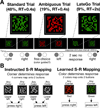Medial prefrontal cortex predicts internally driven strategy shifts
- PMID: 25819613
- PMCID: PMC4425426
- DOI: 10.1016/j.neuron.2015.03.015
Medial prefrontal cortex predicts internally driven strategy shifts
Abstract
Many daily behaviors require us to actively focus on the current task and ignore all other distractions. Yet, ignoring everything else might hinder the ability to discover new ways to achieve the same goal. Here, we studied the neural mechanisms that support the spontaneous change to better strategies while an established strategy is executed. Multivariate neuroimaging analyses showed that before the spontaneous change to an alternative strategy, medial prefrontal cortex (MPFC) encoded information that was irrelevant for the current strategy but necessary for the later strategy. Importantly, this neural effect was related to future behavioral changes: information encoding in MPFC was changed only in participants who eventually switched their strategy and started before the actual strategy change. This allowed us to predict spontaneous strategy shifts ahead of time. These findings suggest that MPFC might internally simulate alternative strategies and shed new light on the organization of PFC.
Copyright © 2015 Elsevier Inc. All rights reserved.
Figures





Similar articles
-
Modulation of memory formation by stimulus content: specific role of the medial prefrontal cortex in the successful encoding of social pictures.J Cogn Neurosci. 2007 Feb;19(2):351-62. doi: 10.1162/jocn.2007.19.2.351. J Cogn Neurosci. 2007. PMID: 17280522
-
The role of the lateral prefrontal cortex and anterior cingulate in stimulus-response association reversals.J Cogn Neurosci. 2007 Jan;19(1):13-24. doi: 10.1162/jocn.2007.19.1.13. J Cogn Neurosci. 2007. PMID: 17214559
-
Specific and nonspecific neural activity during selective processing of visual representations in working memory.J Cogn Neurosci. 2010 Feb;22(2):292-306. doi: 10.1162/jocn.2009.21250. J Cogn Neurosci. 2010. PMID: 19400681
-
Active ignoring in early visual cortex.J Cogn Neurosci. 2011 Aug;23(8):2046-58. doi: 10.1162/jocn.2010.21562. Epub 2010 Aug 31. J Cogn Neurosci. 2011. PMID: 20807054
-
Transient reduction of visual distraction following electrical stimulation of the prefrontal cortex.Cognition. 2015 Dec;145:73-6. doi: 10.1016/j.cognition.2015.08.010. Epub 2015 Aug 28. Cognition. 2015. PMID: 26319971 Free PMC article.
Cited by
-
Human Representation Learning.Annu Rev Neurosci. 2021 Jul 8;44:253-273. doi: 10.1146/annurev-neuro-092920-120559. Epub 2021 Mar 17. Annu Rev Neurosci. 2021. PMID: 33730510 Free PMC article. Review.
-
An inductive bias for slowly changing features in human reinforcement learning.PLoS Comput Biol. 2024 Nov 25;20(11):e1012568. doi: 10.1371/journal.pcbi.1012568. eCollection 2024 Nov. PLoS Comput Biol. 2024. PMID: 39585903 Free PMC article.
-
ACC neural ensemble dynamics are structured by strategy prevalence.Elife. 2023 Nov 22;12:e84897. doi: 10.7554/eLife.84897. Elife. 2023. PMID: 37991007 Free PMC article.
-
Decoding cognition from spontaneous neural activity.Nat Rev Neurosci. 2022 Apr;23(4):204-214. doi: 10.1038/s41583-022-00570-z. Epub 2022 Mar 8. Nat Rev Neurosci. 2022. PMID: 35260845 Review.
-
Human midcingulate cortex encodes distributed representations of task progress.Proc Natl Acad Sci U S A. 2018 Jun 19;115(25):6398-6403. doi: 10.1073/pnas.1803650115. Epub 2018 Jun 4. Proc Natl Acad Sci U S A. 2018. PMID: 29866834 Free PMC article.
References
-
- Botvinick MM, Braver TS, Barch DM, Carter CS, Cohen JD. Conflict monitoring and cognitive control. Psychol. Rev. 2001;108:624–652. - PubMed
Publication types
MeSH terms
Substances
Grants and funding
LinkOut - more resources
Full Text Sources
Other Literature Sources
Miscellaneous

